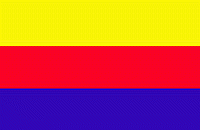Curuzú Cuatiá (Curuzú Cuatiá)
 |
The area has an undulated terrain, with many small rivers and streams that empty into the Paraná River in the west, or into the Uruguay River in the east. The climate is wet subtropical, with uniformly distributed annual rainfall of 1,200 mm on average. The average temperatures are 14.5 °C (winter) and 26 °C (summer), with recorded extremes of −3 °C and 44 °C respectively.
The city is served by an airport, located at -29.78333°N, -58.01667°W.
The name Curuzú Cuatiá is of Guaraní origin and means "Engraved Cross". The early settlers (Spanish conquistadores and Jesuit missionaries from Uruguay) called it Posta de Cruz since the site was a crossroads, marked by a large cross with an inscription.
After the May Revolution that initiated the struggle for independence of Argentina from Spain, the army led by General Manuel Belgrano passed by. Belgrano solved a government conflict in the area by assigning the jurisdiction to the Cabildo of Corrientes. On 16 November 1810 he dictated the official foundation of the city, which (respecting the wishes and beliefs of the population) he named Nuestra Señora de Pilar de Curuzú Cuatiá ("Our Lady of Pilar of Curuzú Cuatiá").
The area saw several important battles during the centralist-federalist struggle, the most remarkable being the Battle of Pago Largo (31 March 1839) against Entre Ríos supporters of Juan Manuel de Rosas.
The town was officially assigned the category of village (villa) on 9 October 1852, and became a city on 25 October 1888.
Map - Curuzú Cuatiá (Curuzú Cuatiá)
Map
Country - Argentina
 |
 |
| Flag of Argentina | |
The earliest recorded human presence in modern-day Argentina dates back to the Paleolithic period. The Inca Empire expanded to the northwest of the country in Pre-Columbian times. The country has its roots in Spanish colonization of the region during the 16th century. Argentina rose as the successor state of the Viceroyalty of the Río de la Plata, a Spanish overseas viceroyalty founded in 1776. The declaration and fight for independence (1810–1818) was followed by an extended civil war that lasted until 1861, culminating in the country's reorganization as a federation. The country thereafter enjoyed relative peace and stability, with several waves of European immigration, mainly Italians and Spaniards, radically reshaping its cultural and demographic outlook; over 60% of the population has full or partial Italian ancestry, and Argentine culture has significant connections to Italian culture.
Currency / Language
| ISO | Currency | Symbol | Significant figures |
|---|---|---|---|
| ARS | Argentine peso | $ | 2 |
| ISO | Language |
|---|---|
| EN | English language |
| FR | French language |
| DE | German language |
| GN | Guarani language |
| IT | Italian language |
| ES | Spanish language |















